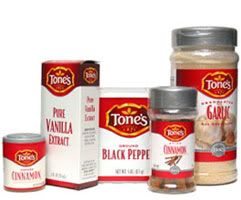(11 am. – promoted by ek hornbeck)
Governments at all levels around the country are facing severe budget problems, and that includes the city of Ankeny, IA. Ankeny shares a problem with lots of other cities — a lack of road salt. As our friends at the Salt Institute know, road salt is spread on roads to help melt ice and snow. It can be a big expense for city governments, and a snowy winter last year hit city government budgets hard and created a road salt shortage heading into this winter:
Some towns are paying as much as $170 a ton as salt prices nationwide soar because of shipping problems and surging demand. Hoping for the best – but preparing for the worst – communities are making plans to stretch supplies by mixing salt with sand, brine or even beet juice.
Ankeny, unfortunately, does not have a lot of spare beet juice lying around. But they do have a Tone’s Spices plant. And Tone’s just happened to have 9 tons of excess garlic salt lying around which they graciously donated to the city of Ankeny.

It snowed on Tuesday. But Ankeny was ready. City crews mixed the garlic salt with their dwindling supply of road salt and hit the streets. The result? Clean, safe streets that smell like a big outdoor Olive Garden. And the city saved $1400. But a city the size of Ankeny (population 36,000) typically uses about 2000 tons of road salt in a winter season, so the 9 tons of garlic salt won’t last long. Buying extra road salt is expected to be very expensive this winter as prices have increased about 30%:
Dick Hanneman, president of the Salt Institute – a trade group representing U.S. and Canadian salt manufacturers – said the price increase was caused by a “perfect storm” of factors.
Record snow in parts of the U.S. last winter depleted road salt supplies, even though suppliers shipped a near-record 20.3 million tons, up from the average 16 million tons a year through the previous decade, he said.
Then, fearing a repeat of the problem, many states increased their salt orders this year, Hanneman said. Illinois, for example, asked for 34 percent more and Iowa’s request spiked by 52 percent.
The availability and price of road salt aren’t the only problems. The environmental effects of dumping 8 to 12 million tons of road salt per year across the country are gaining more attention. Some examples:
– Salt destroys soil structure by killing some soil bacteria. This allows more soil to erode into streams, taking the salt with it. Salt erosion contaminates drinking water to levels that exceed public consumption standards.
– Salt doesn’t evaporate, or otherwise get removed once applied, so it remains a persistent risk to aquatic ecosystems and to water quality. Approximately 55 percent of road-salt runs off with snow melt into streams, with the remaining 45 percent infiltrating through soils and into groundwater aquifers according to a 1993 study.
– Salt corrodes metals like automobile brake linings, frames, and bumpers, and can cause cosmetic corrosion. To prevent this corrosion, automakers spend almost $4 billion per year.
– Salt can penetrate concrete to corrode the reinforcing rods causing damage to bridges, roads and cracked pavement.
There are efforts to develope more environmentally friendly alternatives to road salt. Calcium Magnesium Acetate (CMA) is a product that is gaining use on roads but is still significantly more expensive than road salt. It is biodegradeable and far less corrosive than road salt. And if you have ever peed in the snow you’ve noticed the snow melts — this is an example of how urea (also known as carbamide) can be used as an alternative to road salt. One option for home use on sidewalks and driveways is alfalfa meal:
The most natural (in the sense of something being used in a way that can be found in nature) ice melter is alfalfa meal. This is a totally natural fertilizer that contains nitrogen to promote ice melting and has a texture to provide traction while it works. While this also can cause algae bloom in our waterways, it will be less pervasive a problem than with using urea.
For now, Ankeny’s budget problems and road salt shortage remain. But the waft of garlic from its streets should keep Ankeny safe from vampires.

19 comments
Skip to comment form
Author
…and thanks for reading.
Also (and probably foolishly) posted at dKos.
The really cool thing for the town of Ankeny is that they won’t have Vlad Cheney doing any pheasant hunting there once his ass is outta office.
😉
in my life is the amount of time I’ve spent in traffic jams as a result of snow/ice and temps so cold that salt doesn’t work to melt it. Oh, and then there’s the shoveling. Sounds like more coming today. What a way to live!!!! I’m seriously considering hermitude until its all over.
and more coming for the week of the solstice
very little salt is used here due to it effects on the fisheries and drinking water for LA
mostly sand is what is used here